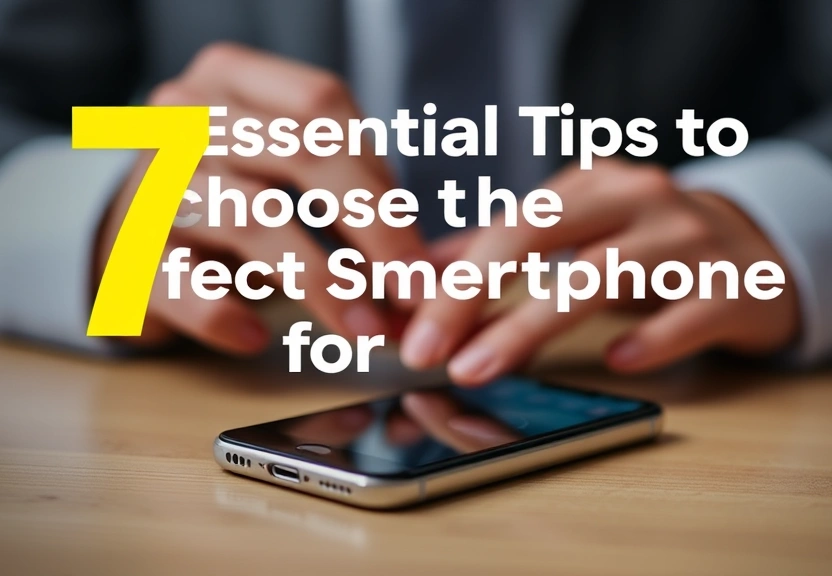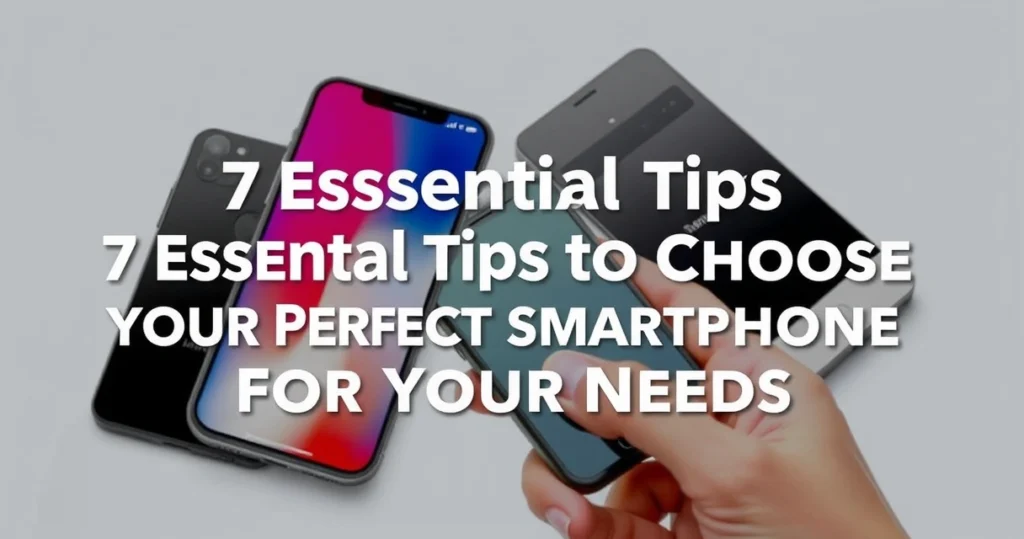7 Essential Tips to Choose the Perfect Smartphone for Your Needs
The modern smartphone market is flooded with options, making the process of selecting the ideal device a daunting task. With various brands, models, and specifications to consider, it’s crucial to approach your smartphone selection methodically. Whether you’re upgrading your old phone or purchasing your first one, understanding your unique needs and preferences is essential for making an informed decision.

In this article, we will guide you through seven essential tips to help you choose the perfect smartphone for your needs. From budget considerations to technical specifications, we aim to provide you with a comprehensive understanding of what to look for when purchasing a new smartphone. Let’s dive in!
1. Determine Your Needs
Before you start browsing smartphones, it’s important to assess your specific requirements. Knowing how you intend to use your smartphone will significantly narrow down your choices. Here are some questions to consider:
- Will you primarily use your phone for social media, gaming, or professional tasks?
- Do you require a high-quality camera for photography or videography?
- How important is battery life for your daily activities?
By answering these questions, you can better understand which features are essential for you, making it easier to filter out unnecessary options.
2. Set a Realistic Price Range
The smartphone selection process starts with establishing a budget. Smartphones are available across a wide range of price points, so knowing how much you’re willing to spend will help you focus on options that fit your financial plan. Here’s how to set a realistic price range:
- Consider your current phone’s value; if you’re trading it in, factor that into your budget.
- Look for deals and promotions from various retailers.
- Think about long-term costs, such as insurance and accessories.
By setting a price range, you can avoid overspending and make a more informed decision based on what features you can realistically afford.
3. Understand Technical Specifications
Once you have a clear idea of your needs and budget, it’s time to delve into the technical specifications. Here are some key components to consider:
Processor
The processor, or chipset, is the heart of your smartphone. It determines how quickly your device can perform tasks. Look for devices equipped with the latest processors for optimal performance, especially if you plan on using demanding applications or games.
RAM
Random Access Memory (RAM) affects your device’s ability to multitask. A smartphone with at least 4GB of RAM is advisable for basic tasks, while 6GB or more is recommended for heavy users who run multiple applications simultaneously.
Storage Capacity
Storage capacity is crucial, especially if you plan to store large files, applications, or media. Consider devices with at least 64GB of internal storage, and check if they support expandable storage via microSD cards.
Camera Features
The camera is often a decisive factor in smartphone selection. Look for features such as:
- Megapixel count
- Optical Image Stabilization (OIS)
- Multiple lens options (wide-angle, telephoto)
Evaluate sample images and reviews to gauge camera performance in real-world conditions.
4. Assess Battery Life
Battery life is a critical aspect of smartphone usability. A device with insufficient battery capacity can lead to frustration during daily use. Consider the following factors when evaluating battery life:
- Battery Capacity: Look for devices with a minimum of 3000 mAh for all-day usage.
- Battery Optimization: Some smartphones come with advanced power-saving modes that can extend battery life.
- Charging Options: Check for fast charging capabilities and whether the device supports wireless charging.
A smartphone that can keep up with your daily activities without frequent charging is essential for a smooth experience.
5. Explore Operating System Options
Your choice of operating system (OS) can significantly impact your smartphone experience. The two most popular OS choices are:
- Android: Offers a wide variety of devices and customization options. It’s ideal for users who appreciate flexibility.
- iOS: Exclusive to Apple devices, iOS is known for its user-friendly interface and seamless integration with other Apple products.
Consider which OS aligns better with your preferences, existing technology, and the apps you frequently use. If you have a preference for a specific ecosystem (like Google or Apple), this will help narrow down your selection.
6. Read Reviews and Comparisons
Before making a purchase, take the time to read reviews and watch comparison videos. User reviews can provide insight into real-world performance, battery life, and software updates. Look for trusted technology review websites and YouTube channels that thoroughly test smartphones.
Pay attention to feedback on:
- Performance in everyday tasks
- Camera quality in various lighting conditions
- Software updates and support from the manufacturer
Comparing multiple models can help you find the best fit for your needs and budget, ensuring you make a well-informed decision.
7. Consider After-Sales Support
After-sales support is often an overlooked aspect of smartphone selection, but it can significantly affect your experience. Investigate the manufacturer’s warranty, customer service reputation, and availability of repair services. Consider the following:
- Warranty Length: Most smartphones come with a one-year warranty, but some brands offer extended coverage.
- Repair Services: Check if there are authorized service centers in your area.
- Customer Support: Look for brands that provide responsive customer service, including chat, email, and phone support.
Choosing a brand with robust after-sales support can save you time and money in the long run.
Frequently Asked Questions (FAQ)
1. What is the most important feature to consider when choosing a smartphone?
The most important feature varies by user, but for many, the camera quality and battery life are crucial. Assess your usage to determine what matters most to you.
2. How much RAM do I need in a smartphone?
A minimum of 4GB of RAM is suitable for basic tasks, while 6GB or more is recommended for heavy multitasking and gaming.
3. Is it better to buy a smartphone outright or through a carrier contract?
Buying outright allows you to avoid long-term contracts and choose the best plan for your needs. However, carrier contracts can provide lower upfront costs.
4. What is the average lifespan of a smartphone?
Most smartphones last between 2 to 4 years, depending on usage and software support. Regular software updates can extend the device’s usability.
5. Should I prioritize brand loyalty when choosing a smartphone?
While brand loyalty can indicate quality and support, it’s essential to evaluate each model on its specifications and how well it meets your needs.
Conclusion
Choosing the perfect smartphone for your needs doesn’t have to be overwhelming. By assessing your requirements, setting a budget, understanding technical specifications, and considering after-sales support, you can make an informed decision. Whether you prioritize camera features, battery life, or operating system, the tips outlined in this article will help you navigate the smartphone market with confidence.
Take your time, conduct thorough research, and don’t hesitate to seek advice from trusted sources. With the right approach, you’ll find a smartphone that enhances your daily life and meets your expectations.
📰 Original Source
Este artigo foi baseado em informações de: https://tecnoblog.net/responde/como-escolher-um-celular-veja-7-dicas-para-comprar-um-smartphone/



